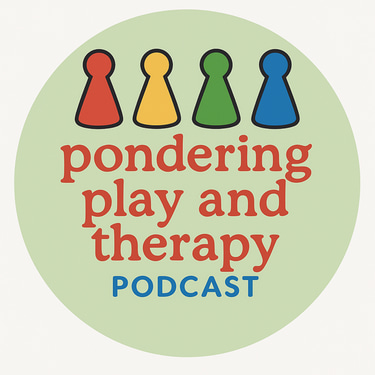Exploring the Depths of Sandtray Therapy: An Insightful Conversation with Marshall Lyles 🎙️
In a recent episode of "Pondering Play and Therapy," Philippa welcomes Marshall Lyles, a renowned therapist with over 20 years of experience in family and play therapy. Hailing from Texas, USA, Marshall shares insights into the world of Sandtray Therapy and its impact across various age groups and therapeutic contexts.
Philippa
6/27/20252 min read


The Journey to Sandtray Therapy
Marshall's transition into the world of therapy was somewhat serendipitous. Initially studying writing and journalism, he found himself invited to a graduate program in family therapy, where he was introduced to Sandtray Therapy. Despite his lack of experience in therapy, Marshall embraced this new path, which led him to a fulfilling career in Sandtray and attachment-informed work. 🪷
What is Sandtray Therapy?
Sandtray Therapy falls under the umbrella of expressive therapy approaches, employing elements like play, music, and drama. Within a Sandtray session, clients use miniature figures to create a world in a sandbox, allowing deep-seated emotions and memories to surface. This method is particularly useful for exploring traumas that are pre-verbal or too painful to articulate directly. 🎨
A Versatile Tool for Healing
Marshall highlights the flexibility of Sandtray Therapy, suitable for clients of all ages, including individuals, couples, families, and groups. It traces its roots back to the early 1900s with Margaret Lowenfeld’s "World Technique," which aimed to help children articulate complex emotions through metaphor and symbolism. Over time, practitioners realised its effectiveness for adults too, especially those navigating trauma and attachment issues.
Sandtray in Practice: Metaphor as a Safe Space
Marshall explains how Sandtray offers a non-judgmental environment where clients can explore their feelings and past experiences through metaphor. This approach allows clients to decide how direct or metaphorical their expressions will be. It is particularly beneficial for those dealing with attachment wounds, providing a platform to process nonverbal and early life experiences.
The Role of the Therapist
In a Sandtray session, the therapist's role can vary. For younger clients, the process might be more interactive, with the therapist engaging in play. For older clients, the interaction may focus more on discussing the story created within the sandbox. The overarching goal is to help clients safely explore their inner worlds while fostering reflection and healing.
Addressing Judgment and Internalised Narratives
Marshall delves into the concept of internalised judgment, explaining how past criticisms, whether familial or societal, often shape self-perception. Sandtray Therapy offers clients a chance to challenge these internal narratives and explore alternative self-concepts. Through compassionate observation and dialogue facilitated by the therapist, clients can slowly dismantle limiting beliefs.
Family Involvement: A Systemic Approach
For therapy with younger clients, family involvement is often crucial. 🌱 Marshall emphasises the importance of engaging the entire family system in the therapeutic process, ensuring that any progress made by the child is supported and reinforced within their home environment. This holistic approach recognises the interconnectedness of familial dynamics in individual healing journeys.
Global Influence and Humility in Practice
Marshall shares his experiences working with therapists globally, particularly in South Africa, Turkey, and Jordan. These interactions have enriched his understanding of cultural contexts and reinforced the need for humility in offering therapeutic support internationally. He believes in empowering local therapists rather than imposing external solutions, facilitating a mutual exchange of knowledge and experience.
Expanding Knowledge through Writing and Resources
Beyond face-to-face interactions, Marshall has co-authored a book titled "Advanced Sandtray Therapy" and regularly contributes to various articles and publications. His writing is accessible on platforms like Substack, where he explores themes such as judgment, poetics, and belonging, offering valuable insights for both therapists and individuals interested in personal growth.
In conclusion, Marshall Lyles’ work demonstrates the profound impact of Sandtray Therapy as a tool for exploring deep-seated emotions, fostering healing, and challenging limiting narratives. His commitment to education and global collaboration continues to elevate the practice, ensuring its availability and efficacy for clients worldwide.
